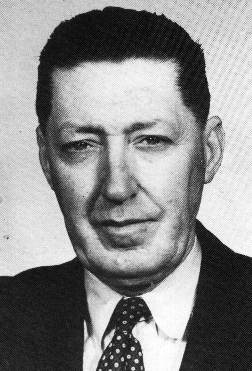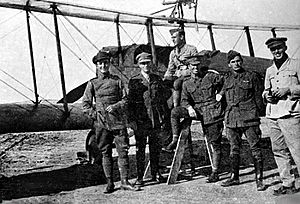Lawrence Wackett facts for kids
Quick facts for kids
Sir Lawrence Wackett
|
|
|---|---|
 |
|
| Born | 2 January 1896 Townsville, Queensland |
| Died | 18 March 1982 (aged 86) St Leonards, New South Wales |
| Allegiance | |
| Service/ |
Australian Flying Corps (1915–21) Royal Australian Air Force (1921–30) |
| Years of service | 1913–1930 |
| Rank | Wing Commander |
| Commands held | RAAF Experimental Section (1924–30) No. 7 Squadron (1919) |
| Battles/wars | World War I
|
| Awards | Knight Commander of the Order of the British Empire Distinguished Flying Cross Air Force Cross Mentioned in Despatches |
| Relations | Air Vice Marshal Ellis Wackett (brother) |
Sir Lawrence James Wackett KBE, DFC, AFC (born January 2, 1896 – died March 18, 1982) is known as the "father of the Australian aircraft industry." He was a key figure in Australian aviation, working as a pilot, designer, and manager. He was made a knight for his important work in aviation and won the Oswald Watt Gold Medal. Lawrence Wackett was also a keen angler and wrote two books about fishing.
Contents
Early Life and Military Service
Lawrence Wackett was born in Townsville, Queensland, on January 2, 1896. He joined the Australian Army and later became a lieutenant. He joined No. 1 Squadron of the Australian Flying Corps (AFC) just before his 20th birthday. He was one of twelve pilots who went to Egypt to help in the Sinai and Palestine Campaign during World War I.
While in Egypt, Wackett made an important improvement to his BE2c aircraft. He designed a way to attach a Lewis Gun to the top wing. This was a big deal because the BE2c usually had a machine gun that was hard to aim. Wackett's change meant he could aim the whole plane at the enemy, making it much better for fighting. He used his improved BE2c effectively in several missions, even fighting off two enemy planes during a reconnaissance flight.
Wackett later moved to No. 3 Squadron AFC in France. He played a big part in the Battle of Hamel on July 4, 1918. He was asked to find a way to drop supplies from planes. Wackett, now a captain, designed a small parachute to drop ammunition to soldiers on the ground. He also created a special bomb rack to hold the supplies. This new method of dropping supplies from aircraft saved many lives. For his brave reconnaissance and supply missions, he received the Distinguished Flying Cross. By the end of the war, he was a major.
Building Australian Aircraft
After World War I, Wackett was one of only 21 officers who started the new Royal Australian Air Force (RAAF) in 1921. He strongly believed that Australia needed to build its own aircraft. He studied aircraft design and won second prize in a competition in 1924 with his first design, the Warbler. This was a small plane with an engine he also designed, called the Wizard.
In 1924, Wackett helped set up the RAAF Experimental Aircraft Section in Randwick, Sydney. He became its leader. He convinced the government to fund the building of a small flying boat. This aircraft was called the Widgeon. It was the first flying boat completely designed and built in Australia. After some repairs and upgrades, the Widgeon I was used by the RAAF for training.
Wackett then developed a larger version, the Widgeon II. He flew this plane himself on a long journey of about 14,000 km (9,000 miles) around Australia in 1928, proving its ability. Other aircraft he designed at Randwick included the Warrigal I and Warrigal II, which were trainer planes.
Moving to Civilian Aviation
In 1931, the Randwick workshop was closed. Wackett left the RAAF as a wing commander and moved to the Cockatoo Island Naval Dockyard. Here, he designed boats as well as aircraft. He supervised the building of a de Havilland Gipsy Moth for the RAAF.
He also worked on civilian planes, including the Cockatoo Docks & Engineering LJW.6 Codock. This was a six-passenger airliner built for famous Australian pilot Sir Charles Kingsford Smith.
In 1934, Wackett joined Tugan Aircraft. He helped design the LJW7 Gannet, a passenger airliner. This was the first of Wackett's designs to be built in large numbers. Eight Gannets were made for civilian use and the RAAF.
Leading the Commonwealth Aircraft Corporation
Soon after, the Commonwealth Aircraft Corporation (CAC) was formed. Tugan Aircraft was bought by CAC, and Wackett became the General Manager. He led the production of the first mass-produced aircraft in Australia, the CAC Wirraway. This plane was based on an American design, the North American NA-16, which Wackett had recommended.
The second aircraft to come from CAC under Wackett's leadership was the Wackett Trainer. The first prototype of this plane flew just after World War II began.
World War II and Beyond
Lawrence Wackett's work was closely tied to the RAAF and CAC for over 20 years. He had a huge impact on the Australian aircraft industry. During World War II, CAC grew rapidly under his guidance. It employed thousands of people and built hundreds of aircraft, engines, and propellers for the war effort.
After World War II, Wackett was again very important in choosing new aircraft for the RAAF. When the RAAF needed to replace its early jet fighters, Wackett pushed for the Sabre jet fighter and the Avon engine to be built under license in Australia. He worked with American and British companies to make this happen. The Australian-built Sabre, known as the Avon-Sabre, was a greatly improved version of the original. It was a very successful project for both the RAAF and CAC.
Later, when it was time to replace the Sabre, Wackett again played a big role in the decision. He helped choose the Dassault Mirage fighter for the RAAF. While CAC hoped to build the Mirage, another company, Government Aircraft Factories, was chosen instead. CAC still built parts like the wings, tails, and engines for the Mirage. Wackett retired in 1966.
Lawrence Wackett passed away on March 18, 1982. Four years later, CAC, the company he had led for so long, closed down. However, his name lives on. In 1991, RMIT University created the Sir Lawrence Wackett Centre for Aerospace Design Technology at the old CAC factory site.
Aircraft Designs by Lawrence Wackett
- LJW1 – Wackett Warbler (1924): A small monoplane with an engine he designed called the Wizard.
- LJW2 – Wackett Widgeon (I) (1925): The first flying boat completely designed and built in Australia.
- LJW3 – Wackett Widgeon II (1928): A larger amphibian (can land on water and land) that Wackett flew on a long journey around Australia.
- LJW4 – Wackett Warrigal I (1929): A two-seat biplane trainer.
- LJW5 – Wackett Warrigal II (1930): An improved version of the Warrigal trainer.
- LJW6 – Cockatoo Docks & Engineering Codock (1930s): A six-passenger airliner built for Sir Charles Kingsford Smith.
- Wackett Waterhen (1931): A proposed two-seat amphibian reconnaissance biplane.
- LJW7 – Tugan Gannet (1935): A six or seven-passenger airliner. This was the first of Wackett's designs to be built in a series.
- "LJW8" – CAC Wackett (1939): A two-seat trainer plane. This was his most successful design, with 200 built for the RAAF. Many were later used for crop dusting after the war.
Awards and Recognition
- Knight Commander of the Order of the British Empire
- Distinguished Flying Cross
- Air Force Cross
- 1974 Royal Federation of Aero Clubs of Australia Oswald Watt Gold Medal
- 1978 Royal Society of New South Wales James Cook Medal
- Fellow of the Royal Aeronautical Society
- 2015 Queensland Business Leaders Hall of Fame
Images for kids






